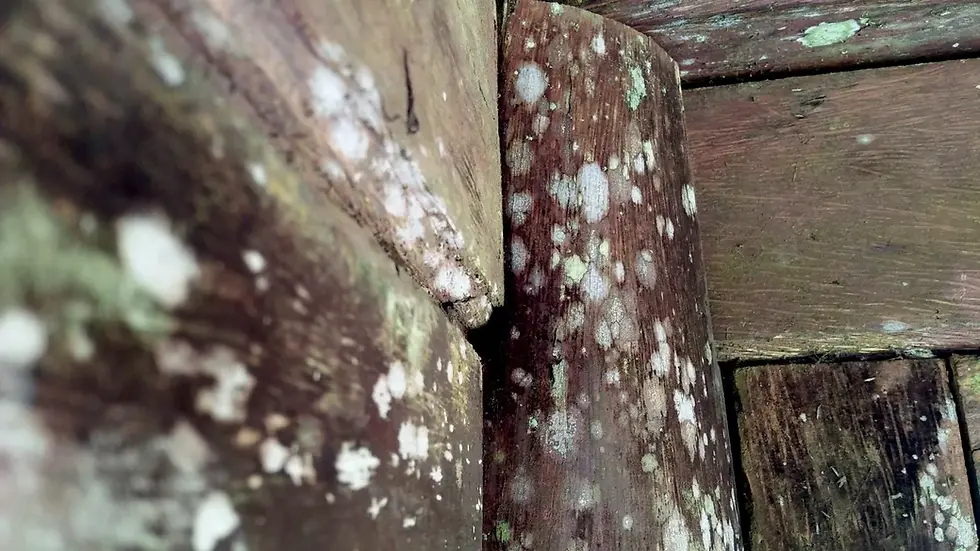Dangers of Mold and How to Prevent it
- Albert
- Aug 28
- 3 min read
Updated: Oct 7
Mold is a common, yet often hidden problem in residential constructions, especially where moisture is present. Its spores thrive in damp, dark environments. The type of foundation plays a crucial role in the likelihood and severity of mold growth.
The most common types of foundations affected by mold are basement and pier-and-beam foundations.
Understanding Basement Vulnerabilities
Basements are particularly vulnerable. They sit below ground level, making them more prone to water intrusion from soil moisture, leaks, or poor drainage. If your basement lacks proper ventilation or hasn’t been waterproofed, it can become an ideal breeding ground for mold.
Risks of Pier and Beam Foundations
Pier and beam foundations also present a high risk for mold growth. Although the house is above ground, the crawlspace beneath can trap humidity and condensation if not properly ventilated. With much of the structure made from wood—like beams, joists, and subflooring—this can quickly become a significant problem for your home and family.
Slab-on-Grade Foundations
Slab-on-grade foundations don’t have basements or crawlspaces. However, moisture can still migrate upward through the concrete slab. If vapor barriers or drainage systems are inadequate, mold can develop under flooring materials or along walls.

Mold spores are everywhere. They come in uninvited when you open a door or window. You might carry them in after walking through the grass, or they may hitch a ride on your children's clothes or backpacks. Once inside, they regroup and start their invasion from any habitable spot. Mold needs only a slightly welcoming environment. Nothing is more inviting than basements and crawlspaces. If the humidity is at 70% or higher, combined with dust and darkness, you’ve created the perfect breeding ground.
Sometimes, mold is easy to spot, like fuzzy growth on food or dark grime in corners with higher humidity. The bigger concern is the mold you don’t see. Up to half of the air you breathe indoors can come from the basement or crawlspace. If those areas are contaminated, the consequences for your health can be serious.

A stale, musty odor is a clear sign of mold. Unfortunately, by the time you notice it, you or your family may already be feeling its side effects. If you or your family are experiencing these issues, especially when at home but not elsewhere, beware:
Frequent allergy-like symptoms: sneezing, runny nose, nasal congestion, or itchy eyes that don’t improve with typical allergy medications.
Persistent cough or throat irritation that seems worse indoors.
Worsening asthma or breathing problems, including wheezing or shortness of breath.
Unexplained skin rashes or irritation (itchy, red, or dry patches).
Chronic headaches or fatigue that improve when away from home.
Musty, earthy odor in certain rooms, closets, or near the foundation.
Visible discoloration or staining on walls, ceilings, or floors (can be green, black, or white patches).
Warped wood, peeling paint, or soft drywall, which may indicate hidden moisture.
Prevention Tips
What can you do to prevent mold growth in your house? Here are some general prevention tips that work for all foundation types:
Maintain indoor humidity between 30–50%.
Repair roof, window, and plumbing leaks promptly.
Use exhaust fans in bathrooms, kitchens, and laundry areas.
Regularly inspect hidden or rarely used areas (closets, storage rooms, under flooring).
Specific Tips for Basements
Keep gutters and downspouts clear, extending them at least 6 feet away from the foundation.
Ensure positive grading to make water slope away from the house.
Install a sump pump with a backup battery if flooding is common.
Use a dehumidifier to keep humidity under 50%.
Seal cracks in walls and apply a waterproof coating to interior basement walls.
Specific Tips for Crawlspaces
Ensure crawlspace vents are unobstructed to allow airflow.
Install a vapor barrier (plastic sheeting) on the soil to reduce ground moisture.
Insulate HVAC ducts and pipes to prevent condensation.
Use a dehumidifier or crawlspace ventilation fan if humidity remains high.
Regularly inspect wood beams and joists for early signs of mold or rot.
Specific Tips for Slab-on-Grade Foundations
Install a high-quality vapor barrier beneath new slabs during construction (or check existing ones).
Keep indoor humidity below 50% using air conditioning or dehumidifiers.
Avoid installing carpet directly on slabs without proper underlayment.
Check plumbing lines that run through or under the slab for leaks.
Seal baseboards and the bottom of drywall to prevent moisture intrusion.
Remember, no matter the foundation type, mold can compromise indoor air quality, damage building materials, and pose health risks to occupants. Understanding how mold develops in different foundation systems is the first step to preventing costly repairs and protecting your home’s long-term integrity.
So keep your home healthy and comfortable for your family by tackling mold and moisture issues early. iFix Foundation Repair provides trusted, expert solutions for all foundation types, helping you protect both your home and your loved ones.
If you want to learn more about how to keep your home safe and mold-free, check out our resources on mold prevention.




Comments